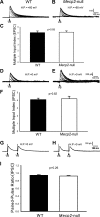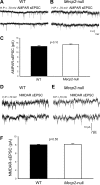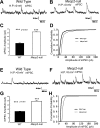Enhancement of postsynaptic GABAA and extrasynaptic NMDA receptor-mediated responses in the barrel cortex of Mecp2-null mice
- PMID: 26683074
- PMCID: PMC4808090
- DOI: 10.1152/jn.00944.2015
Enhancement of postsynaptic GABAA and extrasynaptic NMDA receptor-mediated responses in the barrel cortex of Mecp2-null mice
Abstract
Rett syndrome (RTT) is a neurodevelopmental disorder that results from mutations in the X-linked gene for methyl-CpG-binding protein 2 (MECP2). The underlying cellular mechanism for the sensory deficits in patients with RTT is largely unknown. This study used the Bird mouse model of RTT to investigate sensory thalamocortical synaptic transmission in the barrel cortex of Mecp2-null mice. Electrophysiological results showed an excitation/inhibition imbalance, biased toward inhibition, due to an increase in efficacy of postsynaptic GABAA receptors rather than alterations in inhibitory network and presynaptic release properties. Enhanced inhibition impaired the transmission of tonic sensory signals from the thalamus to the somatosensory cortex. Previous morphological studies showed an upregulation of NMDA receptors in the neocortex of both RTT patients and Mecp2-null mice at early ages [Blue ME, Naidu S, Johnston MV. Ann Neurol 45: 541-545, 1999; Blue ME, Kaufmann WE, Bressler J, Eyring C, O'Driscoll C, Naidu S, Johnston MV. Anat Rec (Hoboken) 294: 1624-1634, 2011]. Although AMPA and NMDA receptor-mediated excitatory synaptic transmission was not altered in the barrel cortex of Mecp2-null mice, extrasynaptic NMDA receptor-mediated responses increased markedly. These responses were blocked by memantine, suggesting that extrasynaptic NMDA receptors play an important role in the pathogenesis of RTT. The results suggest that enhancement of postsynaptic GABAA and extrasynaptic NMDA receptor-mediated responses may underlie impaired somatosensation and that pharmacological blockade of extrasynaptic NMDA receptors may have therapeutic value for RTT.
Keywords: Mecp2 gene; Rett syndrome; barrel cortex; excitation/inhibition balance.
Copyright © 2016 the American Physiological Society.
Figures






References
-
- Albright MJ, Weston MC, Inan M, Rosenmund C, Crair MC. Increased thalamocortical synaptic response and decreased layer IV innervation in GAP-43 knockout mice. J Neurophysiol 98: 1610–1625, 2007. - PubMed
-
- Amir RE, Van den Veyver IB, Wan M, Tran CQ, Francke U, Zoghbi HY. Rett syndrome is caused by mutations in X-linked MECP2, encoding methyl-CpG-binding protein 2. Nat Genet 23: 185–188, 1999. - PubMed
-
- Bader GG, Witt-Engerstrom I, Hagberg B. Neurophysiological findings in the Rett syndrome. II. Visual and auditory brainstem, middle and late evoked responses. Brain Dev 11: 110–114, 1989. - PubMed
-
- Badr GG, Witt-Engerstrom I, Hagberg B. Brain stem and spinal cord impairment in Rett syndrome: somatosensory and auditory evoked responses investigations. Brain Dev 9: 517–522, 1987. - PubMed
Publication types
MeSH terms
Substances
Grants and funding
LinkOut - more resources
Full Text Sources
Other Literature Sources
Medical

